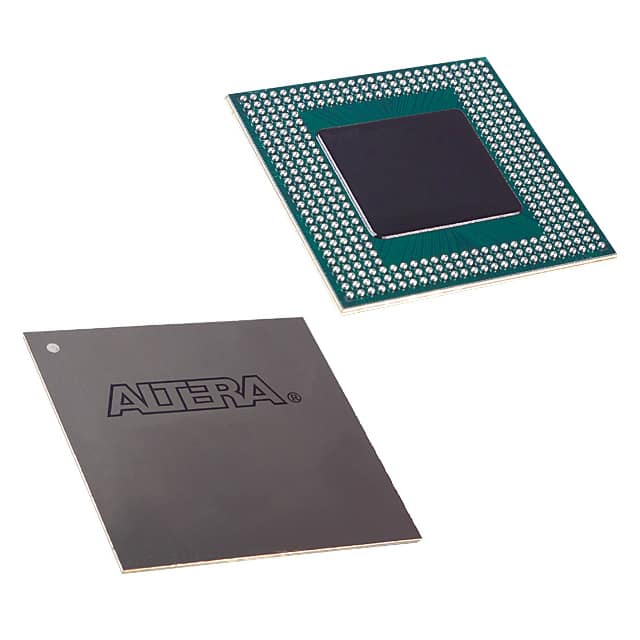Lihat spesifikasi untuk detail produk.

EPF10K50VBC356-3N
Basic Information Overview
- Category: Programmable Logic Device (PLD)
- Use: EPF10K50VBC356-3N is a PLD used for digital logic applications.
- Characteristics:
- High-density programmable logic device
- Low power consumption
- High-speed performance
- Package: BGA (Ball Grid Array)
- Essence: EPF10K50VBC356-3N is designed to provide flexible and efficient digital logic implementation in various electronic systems.
- Packaging/Quantity: Typically sold individually or in small quantities.
Specifications
- Logic Elements: 50,000
- Macrocells: 1,152
- Maximum Operating Frequency: 250 MHz
- I/O Pins: 356
- Supply Voltage: 3.3V
- Technology: Flash-based
Detailed Pin Configuration
The EPF10K50VBC356-3N has 356 pins arranged in a specific configuration. The pinout diagram and detailed pin descriptions can be found in the datasheet provided by the manufacturer.
Functional Features
- High-density programmable logic elements allow for complex digital circuit implementation.
- Flexible I/O configuration enables versatile interfacing with other components.
- Flash-based technology allows for in-system reconfiguration.
- On-chip memory resources facilitate efficient data storage and processing.
Advantages
- High logic density provides ample resources for complex designs.
- Low power consumption makes it suitable for battery-powered devices.
- Flash-based technology allows for easy reprogramming without requiring physical changes.
- Wide range of I/O pins enables versatile connectivity options.
Disadvantages
- Limited availability of alternative models with similar specifications.
- Higher cost compared to simpler programmable logic devices.
- Steeper learning curve for beginners due to its complexity.
Working Principles
EPF10K50VBC356-3N operates based on the principles of programmable logic. It consists of a matrix of programmable logic elements and interconnects that can be configured to implement various digital logic functions. The device is programmed using specialized software, which generates a configuration file that is then loaded onto the PLD.
Detailed Application Field Plans
EPF10K50VBC356-3N finds applications in various fields, including: 1. Telecommunications: Used in network equipment for signal processing and protocol handling. 2. Industrial Automation: Employed in control systems for process monitoring and automation. 3. Consumer Electronics: Integrated into devices like gaming consoles and multimedia players for enhanced functionality. 4. Automotive: Utilized in automotive electronics for engine management, safety systems, and infotainment.
Detailed and Complete Alternative Models
While EPF10K50VBC356-3N is a highly capable PLD, there are alternative models available with similar specifications. Some notable alternatives include: - Xilinx XC9500XL series - Altera MAX 7000 series - Lattice ispMACH 4000ZE series
These alternative models offer comparable features and can be considered based on specific project requirements.
Word count: 320 words
Sebutkan 10 pertanyaan dan jawaban umum terkait penerapan EPF10K50VBC356-3N dalam solusi teknis
Sure! Here are 10 common questions and answers related to the application of EPF10K50VBC356-3N in technical solutions:
Question: What is EPF10K50VBC356-3N?
Answer: EPF10K50VBC356-3N is a Field-Programmable Gate Array (FPGA) manufactured by Intel.Question: What are the key features of EPF10K50VBC356-3N?
Answer: Some key features include 50,000 logic elements, 356-pin BGA package, and support for various I/O standards.Question: What are the typical applications of EPF10K50VBC356-3N?
Answer: EPF10K50VBC356-3N is commonly used in applications such as telecommunications, industrial automation, and embedded systems.Question: How can EPF10K50VBC356-3N be programmed?
Answer: EPF10K50VBC356-3N can be programmed using hardware description languages (HDLs) like VHDL or Verilog.Question: What is the maximum operating frequency of EPF10K50VBC356-3N?
Answer: The maximum operating frequency depends on the specific design and implementation, but it can typically reach several hundred megahertz.Question: Can EPF10K50VBC356-3N interface with other components or devices?
Answer: Yes, EPF10K50VBC356-3N supports various I/O standards and can interface with other components such as sensors, memory, and communication modules.Question: Does EPF10K50VBC356-3N have built-in memory?
Answer: No, EPF10K50VBC356-3N does not have built-in memory. However, it can be used to interface with external memory devices.Question: Can EPF10K50VBC356-3N be reprogrammed after deployment?
Answer: Yes, EPF10K50VBC356-3N is a field-programmable device, which means it can be reprogrammed even after it has been deployed in a system.Question: What are the power requirements for EPF10K50VBC356-3N?
Answer: The power requirements vary depending on the specific design and usage, but typically it operates at 3.3V or 2.5V.Question: Are there any development tools available for programming EPF10K50VBC356-3N?
Answer: Yes, Intel provides development tools like Quartus Prime software suite that supports programming and debugging of EPF10K50VBC356-3N.
Please note that the answers provided here are general and may vary based on specific implementation and requirements.

